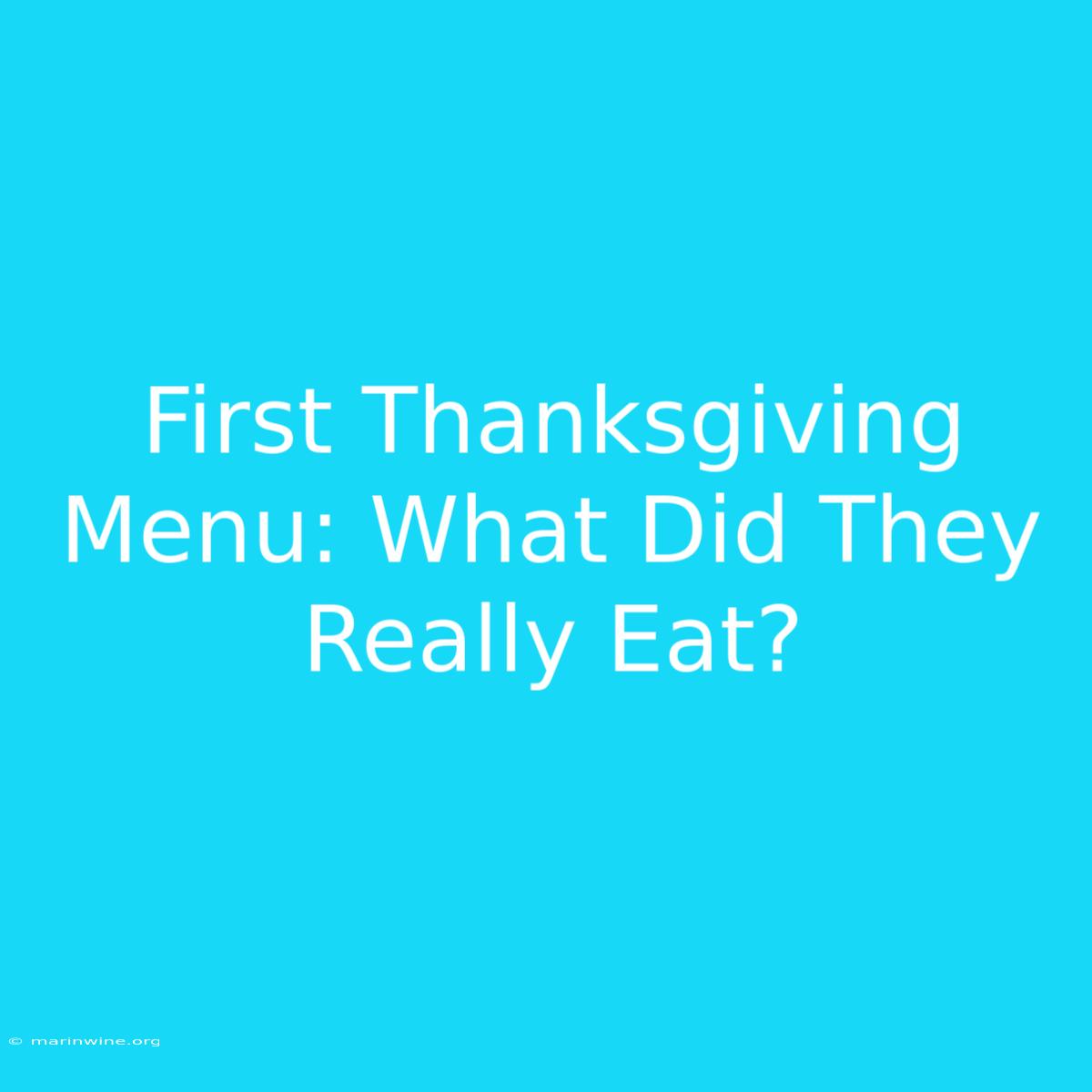First Thanksgiving Menu: What Did They Really Eat?
Editor's Note: New research sheds light on the surprisingly diverse menu of the first Thanksgiving. This article explores the facts behind the legend, separating myth from reality.
Why This Topic Matters
The image of the First Thanksgiving is deeply ingrained in American culture: a bountiful harvest feast shared between Pilgrims and Native Americans. However, the details of that meal are often romanticized. Understanding the actual foods consumed provides valuable insight into the historical realities of the 1621 harvest and the cultural exchange between two vastly different societies. This article will delve into the evidence-based menu, exploring the ingredients, preparation methods, and significance of the food consumed.
Key Takeaways
| Aspect | Description |
|---|---|
| Main Proteins | Wildfowl (turkey, geese, ducks), venison, possibly fish. |
| Vegetables | Squash, beans, corn, wild greens, roots. |
| Fruits | Berries, cranberries (likely not as sauce), nuts. |
| Native American Role | Significant contribution of food and hunting expertise. |
| Bread | Simple, likely made with cornmeal or other locally available grains. |
First Thanksgiving Menu
Introduction
The iconic image of the First Thanksgiving is often inaccurate. While a celebratory feast certainly occurred in the autumn of 1621 at Plymouth, Massachusetts, the menu was likely far more diverse and less "traditional" than the modern-day portrayal. Recent historical research helps paint a clearer, more nuanced picture of this pivotal event.
Key Aspects
The key aspects to consider when reconstructing the First Thanksgiving menu include the available resources, both from the Pilgrims' European farming practices and the Native Americans' extensive knowledge of the local environment. The season also plays a crucial role.
Detailed Analysis
The Pilgrims brought seeds and livestock from England, but the initial harvest was supplemented significantly by the Wampanoag people, who provided a wide array of wild game and gathered foods. While turkey is often associated with Thanksgiving, it was just one of several proteins likely present. Venison, waterfowl (geese and ducks were likely more common than turkey), and possibly fish would have rounded out the protein sources. The vegetables would have included various squashes, beans (likely the Three Sisters – corn, beans, and squash), corn, wild greens, and roots. Fruits would have included local berries and nuts, and while cranberries were available, there's no evidence they were served as the ubiquitous sauce we associate with Thanksgiving. The bread was likely simple, potentially made with cornmeal or a combination of grains.
Interactive Elements
Native American Contributions
Introduction
The Wampanoag people's contribution was essential to the success of the harvest and the feast itself. Their knowledge of the land and hunting skills were vital in providing a diverse and abundant meal.
Facets
- Roles: Provided wild game (deer, waterfowl), fish, gathered fruits, vegetables, and nuts.
- Examples: The abundance of wildfowl suggests skilled hunting techniques. The variety of gathered foods demonstrates intimate knowledge of the local flora.
- Impacts: The feast wouldn't have been the success it was without their generous contribution.
The Myth of the Cranberry Sauce
Introduction
The modern-day association of cranberry sauce with Thanksgiving is a relatively recent development. It's crucial to examine the historical evidence.
Further Analysis
While cranberries were available, there's little historical evidence suggesting they were prepared as a sauce. More likely, they were eaten raw or dried. The cranberry sauce we know today is a much later culinary invention.
People Also Ask (NLP-Friendly Answers)
Q1: What is the First Thanksgiving?
- A: The First Thanksgiving refers to a harvest celebration in 1621 between the Pilgrims and the Wampanoag people in Plymouth, Massachusetts.
Q2: Why is the First Thanksgiving important?
- A: It symbolizes a significant moment of cooperation and shared harvest between two distinct cultures, marking an early chapter in the history of the United States.
Q3: How can I learn more about the First Thanksgiving?
- A: Research historical accounts, visit Plymouth Plantation, or explore museums dedicated to the Plymouth Colony.
Q4: What are the main misconceptions about the First Thanksgiving?
- A: Common misconceptions include the exact menu, the extent of the celebration, and the nature of the relationship between the Pilgrims and the Native Americans.
Q5: How did the Native Americans contribute to the First Thanksgiving?
- A: Native Americans played a vital role, contributing a significant portion of the food and sharing their knowledge of local resources.
Practical Tips for Planning a Historically Accurate Thanksgiving
Introduction
Want to plan a Thanksgiving more reflective of the 1621 feast? Here are some tips to make your meal historically accurate (and delicious!).
Tips
- Incorporate wild game: Consider venison, duck, or goose.
- Feature seasonal vegetables: Squash, beans, corn, and root vegetables were staples.
- Serve simple bread: Use a recipe using cornmeal or a combination of grains.
- Include a variety of berries and nuts: These were abundant in the fall.
- Minimize processed foods and sugars: The original meal was naturally sweet and savory.
- Explore Native American cuisine: Consider incorporating elements of Wampanoag cooking techniques.
- Focus on sharing and community: The spirit of the first Thanksgiving was about community and sharing.
- Research recipes from the period: Use historical cookbooks as inspiration.
Summary
These tips allow you to create a meal that reflects the spirit and flavors of the original Thanksgiving while maintaining a delicious modern approach.
Summary
The First Thanksgiving's menu was far more diverse and less "traditional" than commonly believed. The contribution of the Wampanoag people was crucial, highlighting the cooperative nature of the event. Understanding the historical reality enriches our appreciation of this important moment in American history.
Call to Action
Learn more about the history of Thanksgiving and the Wampanoag people! Share this article to spread the knowledge and help correct common misconceptions.
Hreflang Tags
(Implementation of hreflang tags will depend on the specific CMS and language versions of the article)

